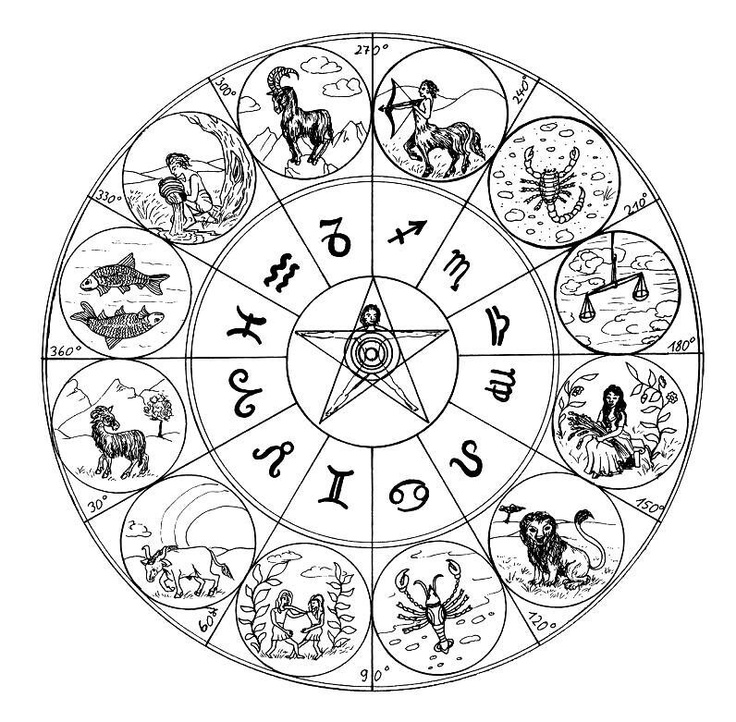
27 Apr AN IN DEPTH EXPLANATION OF PLANETARY INFLUENCES BY Richard Tarnas, Ph.D.
“Everything under creation is represented in the soil and in the stars.
Everything has two witnesses, one on earth and one in the sky.”
~Australian Ngarinyin Elder David Mowaljarlai
ART VIA: The Round Art: The Astrology of Time and Space
∇∇∇
EXCERPTS BELOW BY RICHARD TARNAS FROM HIS ICONIC BOOK
∇∇∇
There are two categories that are most important for understanding the archetypal dynamics of
one’s birth chart and transits: planets and aspects.
The planets represent the essential archetypal forces themselves, while the aspects–
the angular relationships between the planets,
often indicated on the chart by lines drawn between the planetary symbols–
reflect the general nature of the interaction between those archetypal forces.
First I will outline the meanings of the individual planets, then the aspects.
Planets
| Sun | Jupiter |
| Moon | Saturn |
| Mercury | Uranus |
| Venus | Neptune |
| Mars | Pluto |
There are ten planetary archetypes, and it is these that form the foundation of any astrological analysis.
(Following the original ancient Greek usage, the term “planet” in astrology
includes the Sun and Moon as well as Mercury, Venus, Mars, et al.)
Although every planetary archetype plays an important role in one’s chart,
in certain ways the most personally significant are the Sun and Moon.
∇∇∇
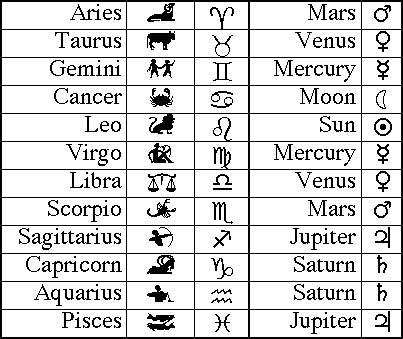
∇∇∇
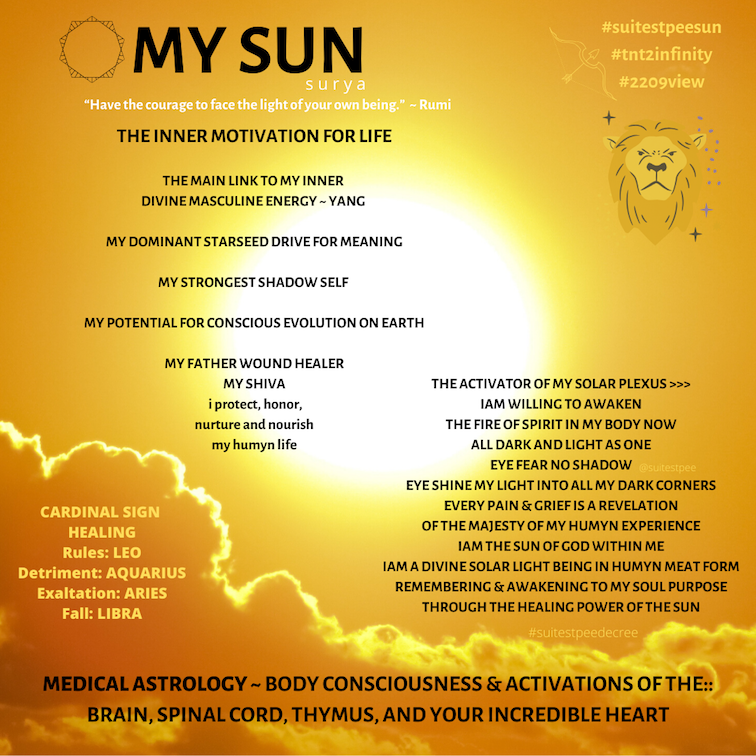
∇∇∇
The Sun represents the central principle of vital energy and conscious selfhood in the birth chart. Just as the Sun is the central entity in the solar system, so is the Sun the central entity in the individual psyche reflected in the birth chart. The Sun represents the center of personal identity, the conscious ego, the autonomous willing self, and is associated with one’s sense of individual self-directedness and self-expression. It rules one’s basic energy drive, the will to exist, to express oneself dynamically as an autonomous individual. It represents that dynamic expression of the personal will which influences and draws upon all the other planetary energies. It is the part of one that, simply put, strives to be: to “shine,” to create, to achieve, to manifest itself. It is tied to one’s basic personal identity in life: “I am John Smith, this is who I am, what I’ve done, where I’m going” etc. In mythic terms, the Sun is associated with the Hero archetype, and is yang in nature.
When the Sun forms a major aspect with another planet in one’s birth chart (for example, a conjunction with Venus, or an opposition with Mars), then this second planetary archetype will tend to be particularly prominent in one’s life and character, infusing its qualities into the basic energy of the self as represented by the Sun. Any major Sun aspects are therefore of great importance in one’s chart. Also, in both women’s and men’s charts, the Sun tends to reflect significant male figures in one’s life.
MY SOLAR AWAKENING >>>
∇∇∇
∇∇∇
The Moon, by contrast, represents the feminine side of the psyche, the anima in Jungian terms. It is closely associated with the emotionally and instinctively responsive personality, with the psychosomatic basis of one’s being, and with the early mother-child relationship. The Moon symbolizes, in a sense, the womb or matrix of one’s being. While the Sun reflects one’s sense of autonomous conscious selfhood, one’s personal identity and will, and is more active and self-directing in nature, the Moon represents more one’s underlying psychological character–those parts of oneself that are more hidden to one’s conscious ego–and is more receptive and spontaneously reactive or responsive in nature. In particular, the Moon corresponds to one’s feelings and those pervasive but largely unconscious psychological patterns that were established deep in one’s past. It is not that the Moon simply is the unconscious; rather it is archetypally associated with what the modern self tends to be unconscious of: the psyche’s emotional, physical, imaginal, familial, and ancestral ground or matrix.
The Moon corresponds to how one feels about oneself even before one thinks about oneself–as well as how one tends to relate spontaneously to others and to life’s various situations. Like the ever-shifting cycles and phases of the Moon, the lunar part of the psyche, associated with one’s moods and feelings, tends to be changeable and fluctuating in character, though on another level its deeply imprinted patterns are very enduring. The Moon concerns one’s immediate psychosomatic mode of response to life that begins in one’s earliest years, that is partly a matter of inheritance, and partly forged in one’s early interactions with the world–especially with one’s mother and other mother-figures, one’s family (siblings, father) and one’s early home environment in general. It governs one’s sense of belonging (or not), how one tends to nurture and be nurtured, and is associated with both the maternal instinct and the needs and instincts of infancy and childhood. In later life, the Moon reflects the nature of all one’s intimate relationships, familial and otherwise, as well as one’s home life. In mythic terms, the Moon is associated with certain aspects of the Great Mother goddess, and is yin in nature.
Again, as with the Sun, if any major aspect is formed between the Moon and another planet in one’s birth chart, this second planetary archetype will tend to be especially significant in one’s life. But in this case that second archetype will tend to channel itself through those parts of one’s life governed by the Moon: one’s emotions and moods, one’s infancy and childhood, one’s mother and early familial environment, one’s intimate relationships and domestic life, and so forth. Also, in both women’s and men’s charts, the Moon tends to reflect significant female figures in a person’s life.
It is important to remember that both women and men have both the Sun and Moon, the basic masculine and feminine archetypes, within their psyche. These principles represent the great yang-yin polarity that pervades existence. It is unclear how much of our masculine and feminine “natures” is culturally conditioned and how much is innate, though certainly there does seem to be a greater intrinsic resonance between the Moon archetype and a woman’s body and psyche in her childbearing and nurturing capacities. However, on another level, it seems to be one of the main challenges for all human beings to attain an inner balance between these two fundamental polarities–between the striving for autonomous individuality and the sense of connectedness to a larger whole, between active and receptive, will and feeling, conscious and unconscious, self and psyche.
LUNAR MEDICINE FOR ALL HUMANS >>>
CLICK TO>>DISCOVER YOUR MOON SIGN
CLICK TO>>FOLLOW THE MOON THROUGH THE ZODIAC
∇∇∇
http://www.science-story.com/sun-dwarf-planets-posters.php
∇∇∇
∇∇∇
Mercury represents the principle of mind, thinking, and the movement or exchange of ideas through speaking, writing, and other forms of communication. It governs the capacity to conceptualize and communicate, to articulate, to use words and language, to analyze and comprehend, to learn, to perceive, to mediate, transport, and connect. The Mercury archetype is associated with the Greek mythic figure of Hermes, the Roman Mercury, the messenger of the gods. A major aspect between Mercury and another planet tends to correlate with how one’s mental and neural processes tend to work, how one gives and receives information, and the nature of one’s education and intellectual vision.
∇∇∇
∇∇∇
Venus represents the principle of love and beauty. Venus is Eros, as Mercury is Logos. Venus rules the desire to be involved in romantic and social relations, to attract and be attracted to others, to engage in artistic activities, to seek harmony and aesthetic or sensuous pleasure. The Venus archetype is associated with the Greek mythic figure of Aphrodite, the Roman Venus, the goddess of love and beauty. Major aspects involving Venus tend to correlate with how one gives and receives love and affection, the nature of one’s social and romantic relationships, and the character of one’s artistic impulse and aesthetic sensibility.
∇∇∇
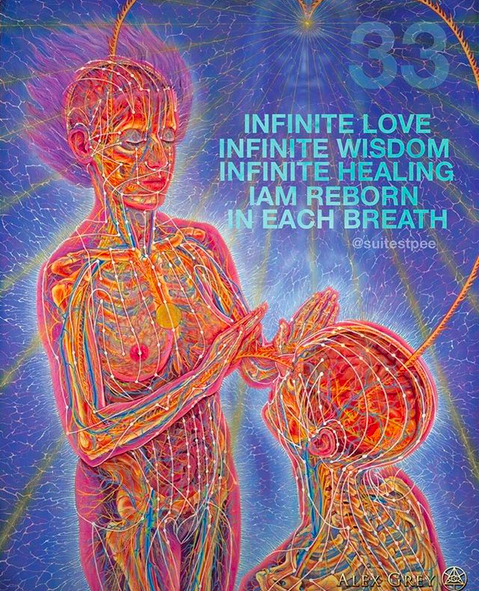 ART:: ALEX GREY
ART:: ALEX GREY
∇∇∇
Mars represents the principle of energetic force. It symbolizes that part of the psyche which impels us to act, to assert ourselves, to struggle, to press forward and against, to be courageous and vigorous, to be competitive or combative. Mars is the archetypal warrior: it governs the capacity for aggressiveness, anger, and physical energy, as well as tendencies toward injury, violence, and impulsiveness. It is connected with athletic activity, and also, as the polar complement to Venus, governs the yang aspect of sexuality. The Mars archetype is associated with the Greek mythic figure of Ares, the Roman Mars, the god of war. Major aspects involving Mars are indicative of how one tends to act and assert oneself in life and how one experiences conflict and aggression.
∇∇∇
http://www.science-story.com/sun-dwarf-planets-posters.php
∇∇∇
∇∇∇
Jupiter represents the principle of expansion and success. It governs the tendency to expand and grow, to elevate and uplift, to seek that which is better or higher, to improve and magnify, to incorporate that which is external, to make larger wholes. It also governs the tendency to experience success, honor, abundance, happiness, and good fortune, and is connected with the capacity for magnanimity, liberality, pride, and optimism. In addition Jupiter corresponds to a concern with moral and philosophical ideals and principles, with long-range or broad perspectives, with the urge for intellectual and cultural breadth, and more generally with the striving for breadth of experience (e.g., through travel, wide reading, inner exploration, etc.). On the negative side, Jupiter is connected with the tendency toward excess, inflation, extravagance, overconcern with wealth and status, self-indulgence, complacency, overconfidence, and sense of personal superiority.
The Jupiter archetype is associated with the Greek mythic figure of Zeus, the king of the Olympian gods, the Roman Jupiter; called the Great Benefic, it is related also to Fortuna and Providence. Major aspects involving Jupiter tend to indicate the nature of one’s experience of personal expansion, growth, and success in all realms of life, as well as how impulses in these directions might be excessive.
∇∇∇
∇∇∇
Saturn is the next planetary archetype to discuss, and because it is an especially complex archetype I will describe it in more detail. Saturn represents the principle of limit, structure, and necessity. It governs the material world, time, tradition, the past, aging, death, and the endings of things. The Saturn archetype is associated with the Greek mythic figure of Kronos, the stern father of the gods, the Roman Saturn. Called the Great Malefic in traditional astrology, it is associated with such archetypal figures as Fate, Father Time, Death, and the Grim Reaper. In Jungian and archetypal psychology, Saturn is often called the senex.
Saturn represents the hard structure of things, the reality principle, the bottom line. It is in many ways the opposite of Jupiter in nature: where Jupiter expands and grants success, Saturn contracts and inhibits; where Jupiter is liberal and magnanimous, Saturn is conservative and strict; where Jupiter uplifts, Saturn oppresses. Indeed, Saturn can well seem to be a one-sidedly negative planet in the astrological pantheon, though in fact the situation is much more complicated. Saturn opposes and limits, but in doing so, it strengthens, grounds, forges, gives our soul substance and gravitas, makes us real.
In an important sense, Saturn is the ruler of the birth chart itself, for Saturn is Time, Chronos, as well as that which fixes a moment in time, creates through birth a separate embodiment of reality, and then sustains and works out through time all the meaning and challenges of that archetypal moment.
Saturn is the archetype that rules the structure of our lives. It is the matrix of things, that which provides both limit and structure, thereby permitting the possibility of manifestation itself. In limiting and bringing closure, Saturn defines. Saturn is also the principle of judgment, governing the consequences of our actions, confronting us with our past. Esoterically, it is considered to be the planet of karma, the carrier of karma from past lifetimes, the consequences of which we now have to encounter in the present life. It might be seen as the cross we bear, for it concerns our trials and sufferings which may often seem inexplicable and undeserved. In theological terms Saturn bears resemblance to some (though not all) aspects of the Hebrew Yahweh: the strict patriarchal ruler and law-giver of creation, the God of justice and retribution who condemns humankind to a life of separation, labor, suffering, disease, pain in childbirth, and death. Saturn is lord of the realm of finitude, imperfection, and mortality. At a deep level, Saturn can be seen as the archetypal birth labor of existence: that which constricts and limits, rigidifies, alienates, cuts one off from the primal union, makes us die to the womb–but also that which incarnates us, gives us embodiment, form, firmness, substance, material reality.
Saturn is therefore often symbolized as a skeleton, both as a symbol of death, the ultimate consuming power of time, but also as the skeletal structure and foundation of things, without which there would be no form, no stability, no supporting frame of strength and solidity which has slowly evolved through time and experience.
Saturn makes us stand alone and know solitude; it separates us from others–from the womb when we are born, from our childhood family as we grow older, and from everyone as we face our death. Yet it is also Saturn that makes us who we are, that disciplines and orders our existence until it has sculpted our essence. It is the superego inside us–our inner judge and conscience, that complex reflection of internalized social convention, religious tradition, and moral law. Saturn governs the consequences of error, guilt, pessimism, inferiority, depression, deprivation; yet it also gives us the capacity for rigor, order, concentration, endurance, seriousness, fidelity, responsibility, maturity. To continue the comparison with Jupiter, where Jupiter may be inflated, exaggerated, or overoptimistic, Saturn is judicious, grounded, and pragmatic. Saturn works slowly and gradually, painstakingly, often painfully, but effectively, with enduring results.
Saturn rules our work in the world, that which we do to make ends meet, the labor of life. It governs “reality” as we usually think of that term–that which makes concrete demands on us, which confronts us with material limitations, which brings us down to earth. It makes us know defeat, limiting our aspirations and negating our dreams. Saturn resists and oppresses us, and yet also defines us, brings us experience and wisdom, makes us take responsibility for ourselves so that we become our own master. As Nietzsche said, “He who cannot obey himself will be commanded.” It is Saturn alone that can give us that special sense of inner authority which can only be purchased through time and experience.
The position of Saturn in one’s birth chart is thus a matter of great importance, and the major aspects it makes to other planets can tell us much about one’s principal concerns in life. Transits involving Saturn regularly mark periods of major developmental importance, often bringing times of personal trial, but also of deep maturation and the establishment of significant life structures involving one’s career, important relationships, or major karmic responsibilities. Perhaps the main thing to remember–or to adopt as a working hypothesis–is that Saturn indicates that which we have chosen to work with and through in this life in order to achieve a higher level of spiritual awareness. The sufferings and frustrations it may bring can perhaps best be seen as serving a purpose which will in the long run be recognized as worth all the hard labor of life. Again, Saturn is that part of the archetypal birth process which oppresses and alienates, and yet slowly molds and structures, and, in the end, ushers us into a new level of existence. It is the guardian of the threshold.
∇∇∇
∇∇∇
Uranus represents the principle of change, of freedom, rebellion, and revolution. It is associated with unexpected phenomena of all kinds, with sudden surprises and awakenings, with breakthroughs–intellectual, psychological, spiritual. It governs the sudden breakup of established structures, and tends to have an exciting and electric quality. It also rules individualism and originality, invention and technology, creative genius and brilliant mental insight. The planet Uranus, the first planet to be discovered in modern times–in 1781, during an age of radical cultural change and revolution–can best be understood archetypally in terms of the Greek mythic figure of Prometheus, who stole fire from the heavens in rebellion against the gods to give humankind greater freedom.
The Promethean impulse associated with the planet Uranus represents that part of us that seeks to go our own way, to choose our own individual path in life. Its influence inclines one to be changeable, restless, and unpredictable–sometimes irresponsibly so–in a constant quest for personal freedom and new experience. Uranus also mediates creativity and innovation: in its less exalted forms it can signify only eccentricity or lawlessness, but in its highest expression it can indicate real genius, and a capacity for making significant personal or cultural breakthroughs in the course of one’s life. The Prometheus archetype associated with the planet Uranus correlates with that stage in the archetypal birth process in which one is suddenly liberated from the constrictions of the birth canal and experiences sudden freedom, awakening, new life, new identity, a radical expansion of horizons: Prometheus Unbound.
There is another side to this archetype’s energy, however, which can make the experience of Uranus a very different matter. When a person has not integrated the Promethean impulse toward creative freedom, autonomous individualism, and capacity for change, there is a strong tendency to experience this archetype as something that happens to one from without in upsetting, disruptive ways. That is, instead of being ourselves a source of change and independence and excitement, we may tend to have change and unpredictable events thrust upon us, so that we are forced to open up our life to new horizons and new possibilities. Uranus thus confronts the Saturnian part of us that wishes to hold on, to maintain the status quo, to resist change in favor of security, tradition, and the established order.
The rebel-trickster side of the Prometheus archetype can thus come from within or without, and in the latter case a person can feel constantly subject to problematic changes that require one to reorient one’s life. Whether these changes are precipitated by other people, by new psychological or physical conditions, or by external circumstances, their role is to open one’s life to something new. If one is identified excessively with the past, if one tries to hold on to structures that are outmoded, then one will experience Uranus as a disruptive force that at times can be quite uncomfortable. But the potential is always there for one to integrate the archetype, and for one to contact one’s own capacity for freedom and excitement, for openness to the unexpected and the new.
When any planet is in major aspect to Uranus, that second planetary archetype tends to be liberated into expression, often in sudden, unusual, or unexpected ways. The second archetype is given an exciting, creative or innovative stimulation, and can be a source of both freedom and unanticipated change.
∇∇∇
∇∇∇
Neptune is the archetype of the transcendent, of ideal reality, of imagination and the spiritual. It represents the ocean of consciousness that dissolves all boundaries between self and other, between self and universe, between self and God, and between this concrete reality and other realities. In perinatal terms Neptune has much to do with the intrauterine condition in which the child’s being and consciousness are not yet differentiated from the mother’s, where there is a symbiotic union, a melting oceanic feeling. Individuals who contact this primal memory in deep self-exploration often associate that state with the mystical condition of oneness with Nature, union with God, or union with the All, and also with a free-floating consciousness in which many realities–spiritual, imaginative, or illusory–seem to interpenetrate without sharp distinction.
Neptune thus governs the ideal world, whether this be defined as the perfect all-encompassing maternal womb, the spiritual world of ideal reality, or one’s highest dreams and aspirations. Yet, like every other planetary archetype, Neptune has opposite sides, light and shadow. For it can both illuminate one with the highest spiritual truths that transcend the everyday world, and yet also lead one into escapist fantasy, illusion, and deception. Neptune represents Nirvana, the supreme state of mystical bliss where all the divisions and structures of this world are transcended; yet it also represents Maya, the divine play which produces the many illusions of reality that enchant consciousness. Neptune relates to both madness and mysticism, and the line is often hard to draw.
Neptune can also be seen as connected to the Narcissus archetype–that which is absorbed in its own reflection. Again this can be understood as the ultimate Divinity eternally experiencing its infinite consciousness, as reflected in the mystic who is absorbed in blissful meditation; but also as the self-absorbed narcissist, the drug addict or alcoholic, the television couch-potato, the escapist, or the psychotic who can no longer accurately discern what is consensus reality. There is a selflessness and unworldliness to Neptune which is visible in the saint and martyr, the altruistic social worker, the yogi or monk. Yet these same qualities can result in an unhealthy denial of self, a sense of helpless weakness, a regressive impulse away from life and the challenges of being an individual self, or an exaggerated spirituality that would altogether deny the claims of the physical world and physical body. What is required of us, as always, is to find a good balance between the demands of Neptune and those of the other planets.
Neptune rules the basic human drive or thirst for transcendence: the yearning for an invisible ideal, the longing to dissolve one’s boundaries into the cosmic unity, to melt into a dream, to transcend this world of separation and limit, to experience the flow of love and compassion and a transcendence of the boundaries of the personal ego. It is just this drive or thirst that fuels the addictive impulse as well as the spiritual quest. Because of Neptune’s association with the ideal, with a kind of mystical paradise or oceanic womb of which the psyche may have, as it were, archetypal memories, there is often an accompanying sense of loss or longing connected with whatever it touches in the chart.
Because it dissolves one’s boundaries, Neptune tends to sensitize one to everything–to other people and their inner states, to external stimuli, to other realities, and so forth. It greatly increases the intuition, but it can also make one liable to projecting one’s own inner states on to others in a delusive way. Neptune is related to healing abilities, both physical and psychological. It has a refining, purifying, sublimating influence. Yet physically Neptune tends to weaken one’s own body (in favor of the spiritual), just as psychologically it tends to weaken the ego (in favor of the larger whole of consciousness). Its constant dynamic is to dissolve structures, to bring all things back to an undifferentiated unity. Neptune also seems to be related to all things watery, whether the physical ocean or the amniotic fluid in which floats the embryo.
Since it governs the realm of imagination, Neptune can be seen as the source of all imaginative creativity and artistic imagery. It governs myth, dreams, symbols, and the flow of images in consciousness. It is the spiritual matrix of the anima mundi, the world soul or cosmic psyche. Also, as the symbol of the ultimate spiritual unity of all things, Neptune can be seen as the wellspring of love and compassion. It rules faith and hope, a sense of the unseen, the quest for spiritual beauty. It is the mystical religious archetype par excellence.
When a planet is in major aspect to Neptune, that second planetary archetype tends to be especially sensitized, sometimes weakened, sometimes spiritualized, sometimes both. The second archetype tends to be idealized in some way, making it subject to either illusion on the one hand or mystical meaning on the other. It becomes allied to the principle of imagination and the spiritual, and potentially can be a significant channel for the expansion of consciousness.
∇∇∇
∇∇∇
And finally Pluto: the archetype of primordial energy, the universal life force which impels all evolution and transformation. Pluto represents the principle of power itself, of elemental force, of primal libido and aggression, and is essentially identical to Freud’s notion of the id. It is the Dionysian energy of life, the Serpent power, the Kundalini. It compels, empowers, overwhelms, transforms; it destroys and resurrects. Pluto governs the instincts and the forces of nature. It rules the biological processes of birth, sex, and death, and at its deepest level it involves the mystery of death and rebirth.
Pluto rules upheaval, breakdown and decay, but also regeneration and the purifying fire of catharsis. It reflects the archetypal Underworld–the dark, mysterious, and often terrifying reality which lurks beneath the surface of things, beneath our ego and societal conventions and the veneer of civilization, and which is periodically unleashed with great destructive and transformative force. Many of the problematic instincts that lie deep within the human psyche, such as murderous hatred, violent jealousy, compulsive greed and lust and so forth, reflect the activity of Pluto: this is Freud’s broiling cauldron of the instincts. Pluto is visible in the elemental power of a volcanic eruption, of a devouring lion, of a war, of an orgasm, of a mother in the climactic stages of giving birth. It is present in all violent, purgatorial discharge of pent-up energies–from the Earth as in an earthquake, or from the human body and psyche as in therapy or in a psychotic break. Pluto is in many ways the polar complement of Neptune–together they represent the great polarities of Dionysus and Apollo, the chthonic and the transcendent, the volcanic and the oceanic, nature and spirit, instinct and imagination. And, like Neptune, Pluto is unfathomable.
In terms of the archetypal birth process, Pluto corresponds to the stage in which the baby is being powerfully expelled from within the mother’s body in a life-and-death struggle of bloody biology, when the erotic and aggressive instincts are being aroused to the utmost. Pluto thus has two sides, both expressed in the processes of Nature: a destructive side, personified as Kali, the Devouring Mother, and a creative side, personified as Shakti, the universal divine energy that impels all life and evolution. Pluto is what Schopenhauer and Nietzsche called the universal Will–at one level seeming to reflect only blind, driving instinct, at another possessing all the evolutionary intelligence of Nature, the divine Shakti. Pluto is Nature itself, life eternally transforming and overcoming itself in an immense evolutionary dynamic.
It has been said that in the course of life we are all consumed by life’s fire: the only question–and this is where our challenge lies–is whether we will be deformed or perfected by that process.
When a planet forms a major aspect to Pluto, that second planetary archetype tends to be greatly intensified and empowered in one’s life and character, sometimes to a compulsive extreme. It may be a source of power struggles in one’s life, outer or inner, but also of profound personal transformation.
∇∇∇
These, then, are the ten planetary archetypes.
Archetypes are deep and many-faceted, and their meanings constantly open up to one in new ways each time one studies them.
It is also important to remember that, although I have described them here individually,
in actual life they always interact with each other, Pluto with Venus, for example, or Uranus with Mars,
and often three or more interacting simultaneously.
It is these complex archetypal interactions–in the birth chart and in transits–
that form the basis of astrological analysis.
∇∇∇
TRANSMISSION BY RICHARD TARNAS | http://cosmosandpsyche.com/
———
———
ORIGINAL POST SHARED VIA: http://gaiamind.org/AstroIntro.html
◊◊◊
EXPLORE > SUITESTPEE’S IG TV *
ESOTERIC EVOLUTIONARY ASTROLOGY TELEVISION
◊◊◊
IN POST ART::
ALEX GREY >>> https://www.alexgrey.com/art/paintings/sacred-mirrors
◊◊◊


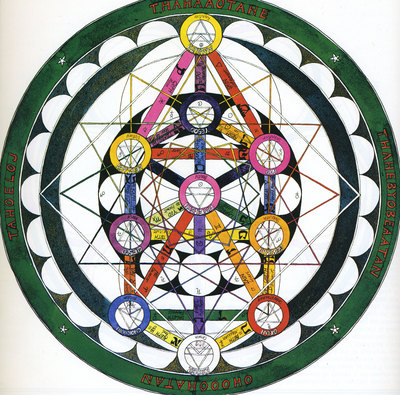
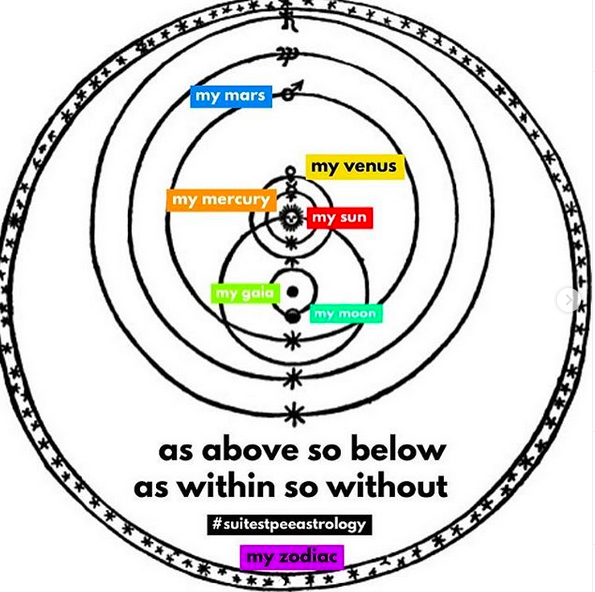

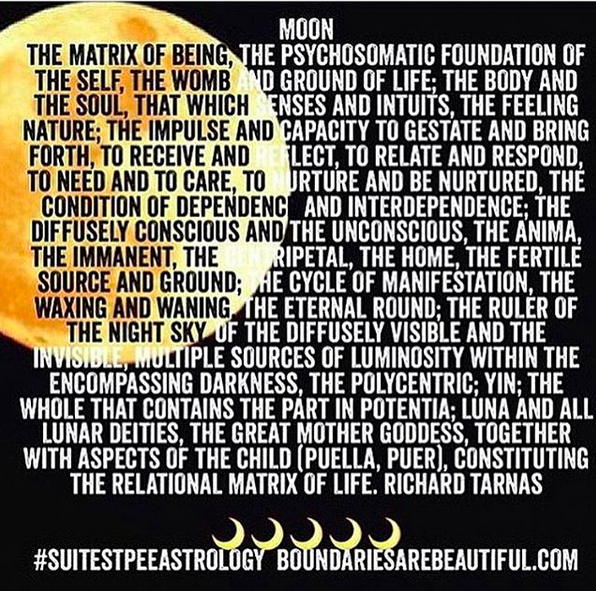
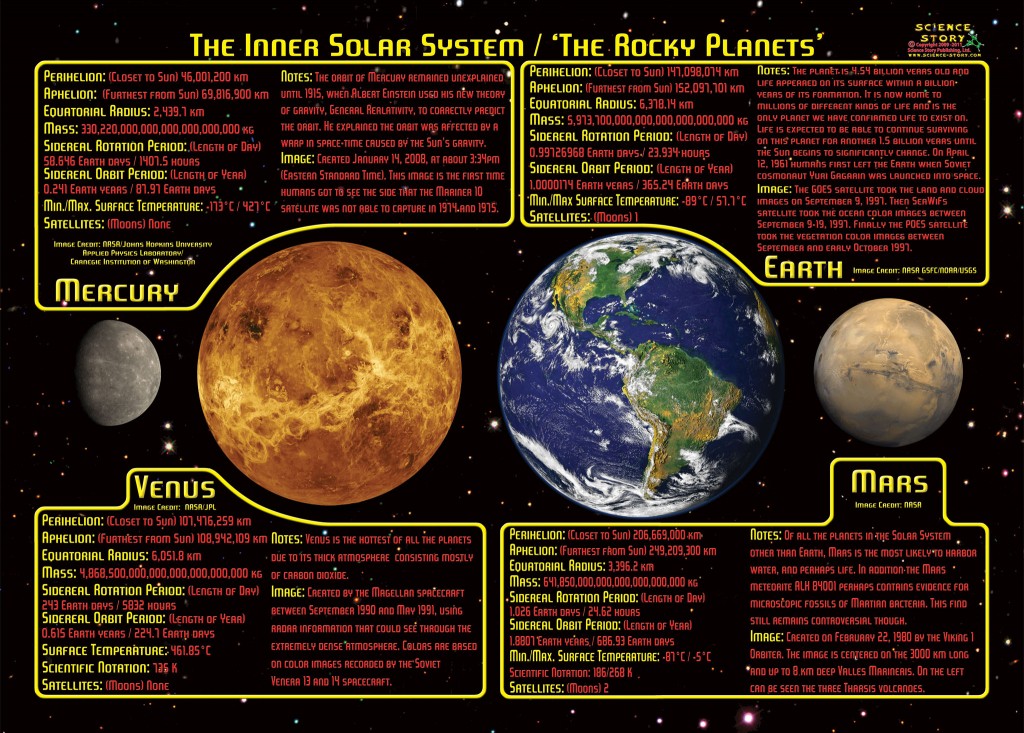
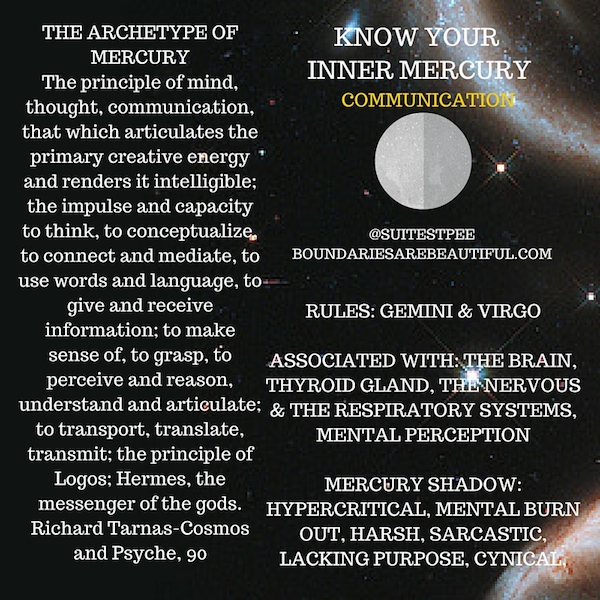
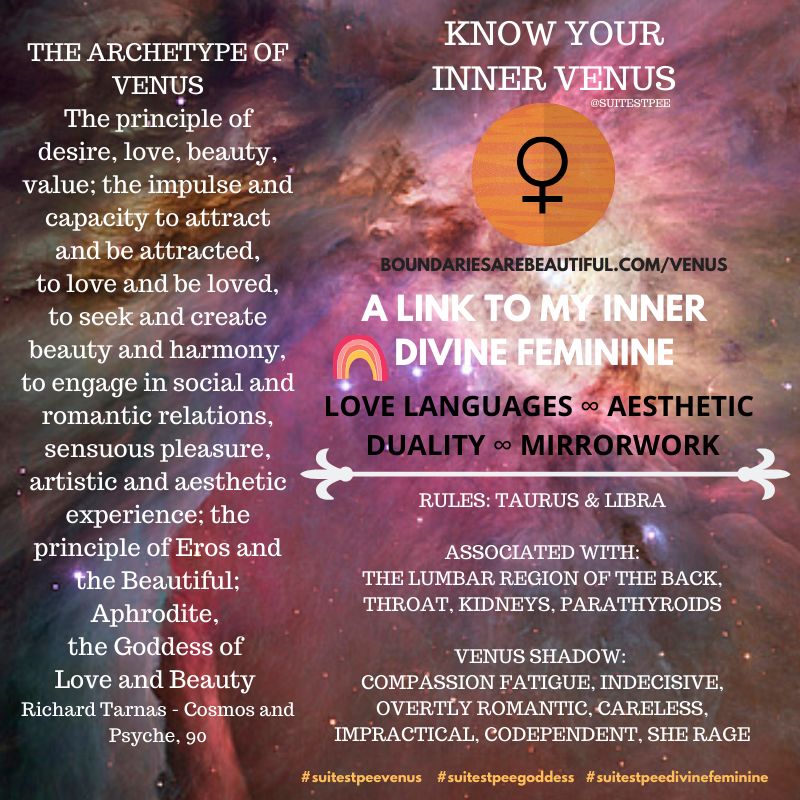
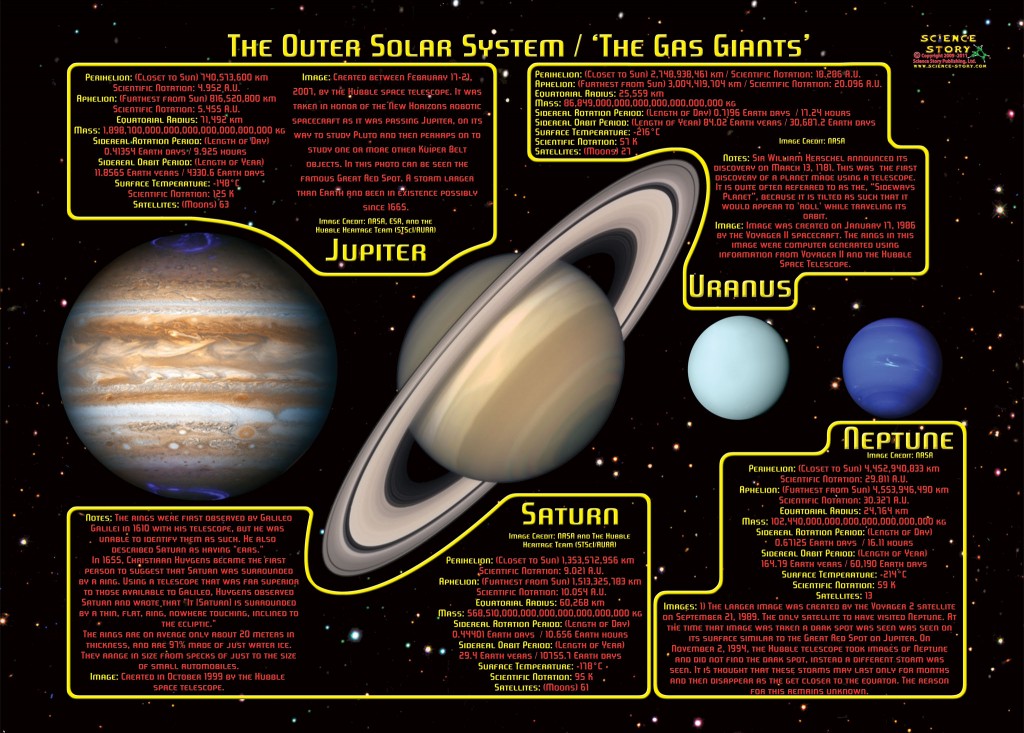
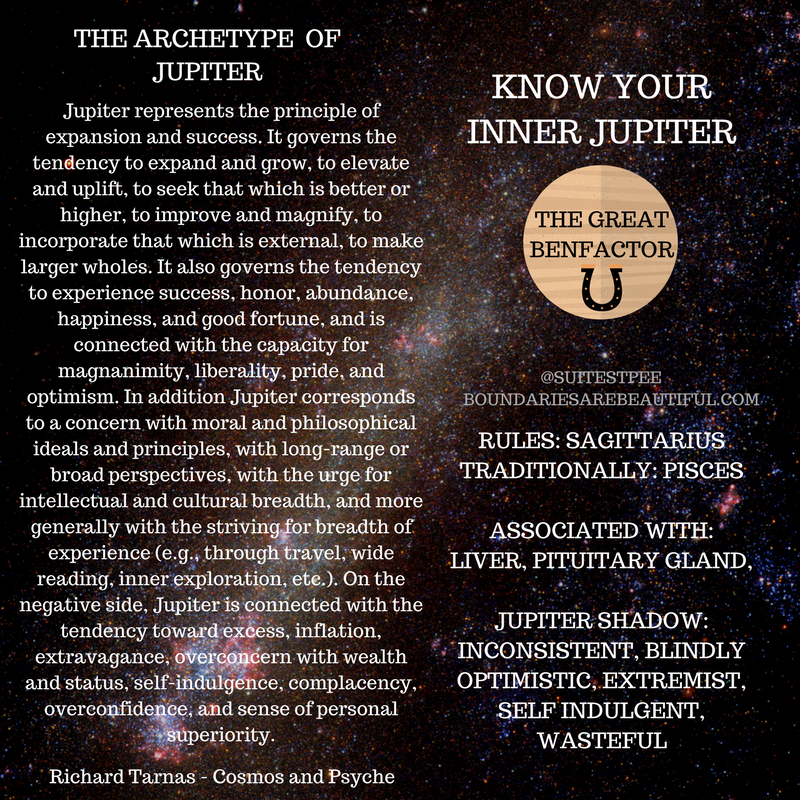
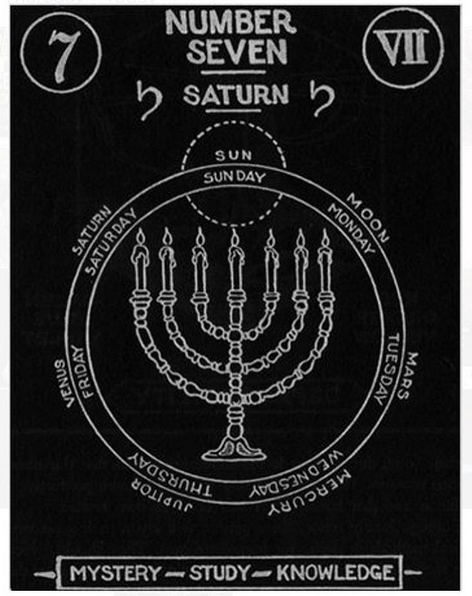

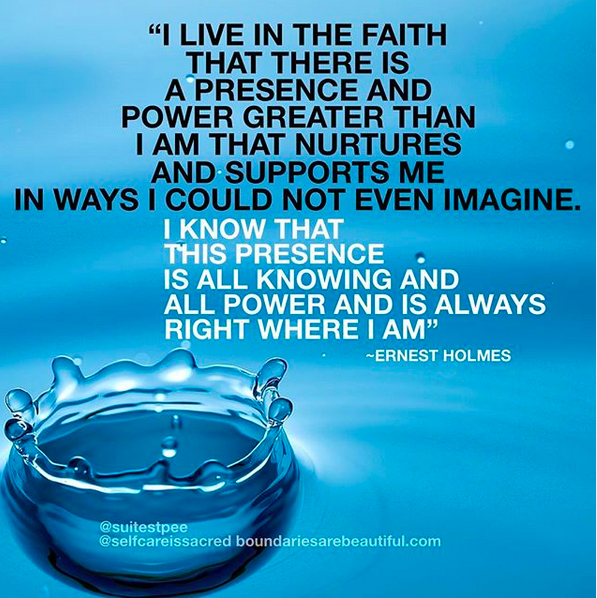
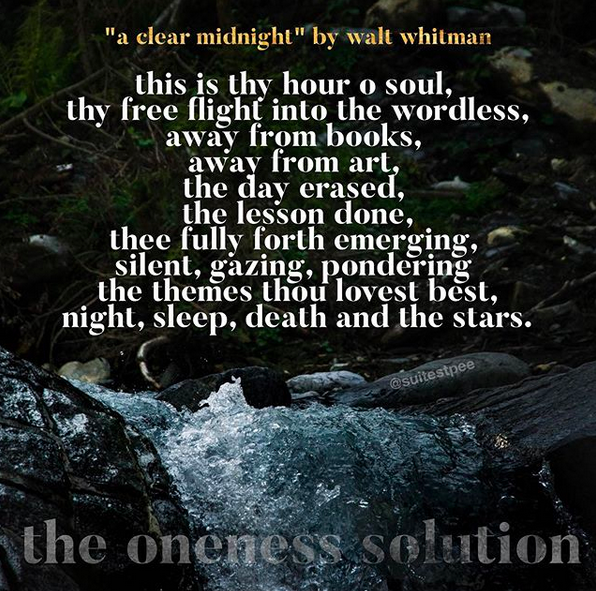

No Comments